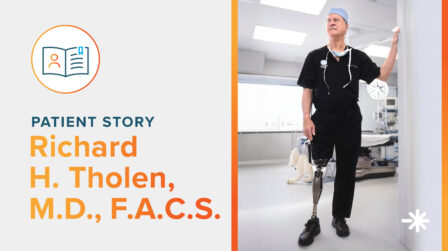From Transaction to Transformation: Creating an Intentional Patient Experience

The patient journey is made up of a number of touchpoints that can have tremendous impact on a patient’s success. Providing a high quality, innovative device or medicine is only part of the equation – the way we deliver care throughout that journey is equally important. A commitment to empathetic listening, deep understanding, and thoughtful action is the first step to intentionally moving beyond the healthcare “transaction” and moving toward creating transformational experiences for patients.
The Evolution of the Healthcare System
When we look at our healthcare system today, we see that it is set up largely as a transactional model:
- There’s something wrong
- I seek help
- I fill out forms…I wait
- I get labs done…I wait
- I get diagnosed
- I pay
- I take my prescription to a pharmacy
- I wait…I pay
As patients, we understand and accept that there are systems in place that allow for these transactions to occur throughout our experience – standardized protocols, documentation requirements, and insurance requirements just to name a few.
When we look at some of these attempts to streamline care delivery, we see that they often miss or take away from the human element of care. People, patients, and caregivers alike are funneled through these processes to make things “more efficient.”
Our thinking about healthcare needs to shift away from the transactional focus and turn back towards the opportunity for transformation – for empathy, kindness, and healing – through human connection.
At Hanger Clinic, we’ve worked hard to intentionally shift our culture to one of service to each other, our patients, and care partners, and crafted a human-centered patient experience we can believe in and rally behind at all levels of the organization, both in the clinic and behind-the-scenes.
Watch Video: The Hanger Clinic Patient Experience
What does “Patient Experience” really mean?
When we, as care providers, think about our patients’ experience, it’s important to take a step back and remind ourselves of the reason they came through our doors in the first place. Whether it was a traumatic injury, stroke, cancer, diabetes, a congenital difference, or some other reason altogether, our patients’ stories began long before they ever encountered us. Whether they came to us one time or whether we have a lifelong relationship with them, the truth is they likely don’t want to be our patient; they need to be our patient. Getting to be a part of their journey toward healing and strength is a real privilege that should be at the core of everything we do and every decision we make.
When starting down the path of understanding and crafting your ideal patient experience, a good place to start is by understanding what it isn’t. It’s not a program. It’s not a campaign. It isn’t a marketing ploy. Instead, it’s something that is ingrained in what we do and who we are – it’s reflected in our team members’ motivations and intentions and reflected in our patients’ outcomes. It’s how each person can influence another person’s life in a positive way when we’re thoughtful and intentional about creating the culture and the experience that we want to deliver.
How to Create a Unified Patient Experience

Intentionally creating an experience is necessary to alleviate the stress that comes with being a patient. But we can’t assume we know what our patients need or want – we have to ask.
At Hanger Clinic, we did this by implementing Net Promoter Score (NPS), which is a proactive patient survey that asks two simple questions – how likely the respondent would be to recommend us to someone else, and why. Initially, our goal with NPS was to listen to our patients’ perceptions of their care and better understand their needs, so we could define and create a world-class patient experience. Now, we use it on a much deeper level. We utilize the feedback to reinforce where we excel and identify areas for improvement, with the ultimate goal of building lasting relationships with our patients.

A culture shift of this magnitude requires buy-in from everyone in the organization. Not just the C-suite or the clinical team, but the office managers, reimbursement team, customer service representatives, and everyone behind the scenes needs to not only believe in it but feel invested in it.
Our approach was to select a team of people from across the organization, in varying roles, departments, and geographies who would be champions for the cause.

The first task of your leadership team should be to distill the findings from your patient surveys into a succinct definition and guiding principles that will drive everything you do. This will serve as the North Star for your organization and will allow your team to set their intention every day to serve each other and your patients in a way that changes lives.
We partner with patients, caregivers and colleagues to provide a consistent, compassionate, human-centric experience on the journey to living empowered lives.
The Hanger Clinic Patient Experience Definition

Properly training your team is arguably the most important element in this process, and it should not be rushed. At Hanger Clinic, it took us two years of in-person and virtual trainings to ensure everyone understood our intentions with NPS and adopted the practice of listening, learning, and continuous improvement. While compassion was always ingrained in who we are, we focused on communications training with an emphasis on empathy, and we empowered team members to create the culture they desired. After all, culture is going to happen and patient experience is going to happen. The question is – is it the culture and experience we intended? Ongoing training and a laser focus on living our organizational values continues at Hanger Clinic, as well as a number of programs aimed at helping our team members develop and grow in service to each other and our patients.

Patient satisfaction with a device is different than their satisfaction with the care they’ve received. Set goals for your team (monthly, quarterly, annually) to ensure you are delivering on your patient experience promise. Don’t settle for meeting the bare minimum of satisfaction. Commit to going beyond and delivering a level of care that is kind, connected, and unified.
Meet the Author
Carrie Davis
Vice President of Patient Experience, Hanger Clinic
As a lifelong prosthetic patient, Carrie draws on her own experience, as well as partnering with patients, caregivers, and colleagues, to intentionally design transformative patient experiences at Hanger Clinic.

Upcoming Professional Events
Join O&P clinical experts and guest speakers from around the world in learning experiences designed to empower you and your healthcare team.
Latest Updates
Subscribe to stay up-to-date on our latest posts.


